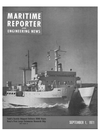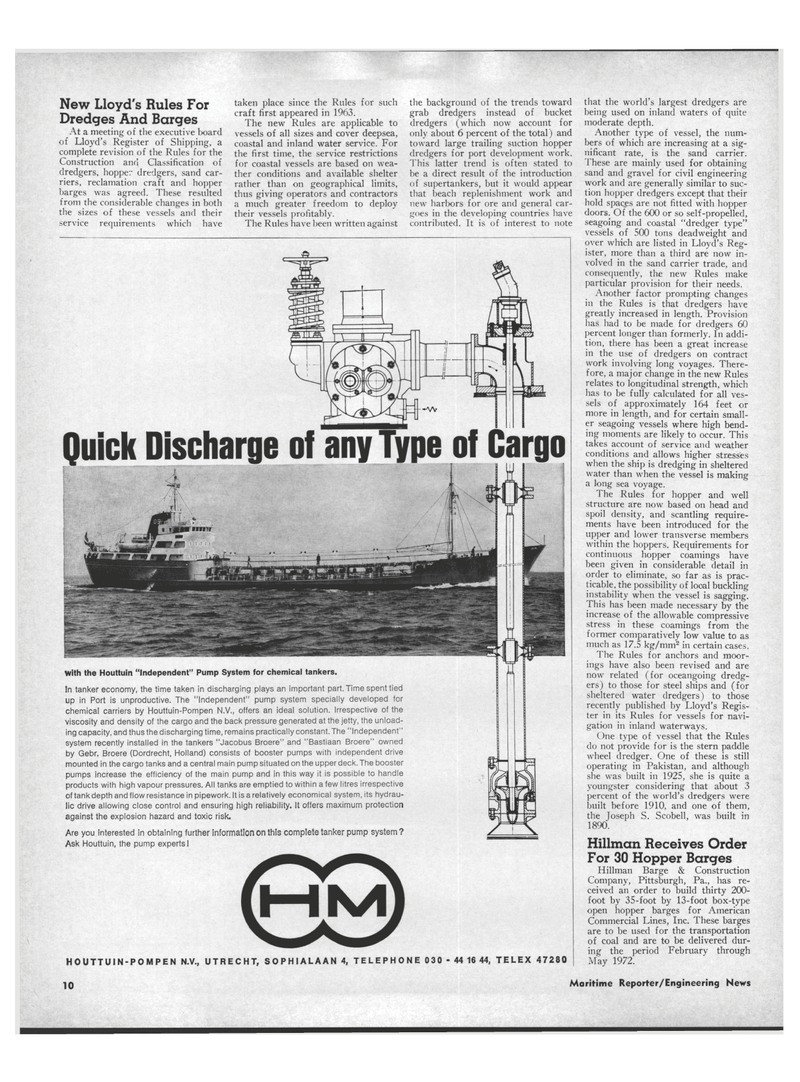
Page 8: of Maritime Reporter Magazine (September 1971)
Read this page in Pdf, Flash or Html5 edition of September 1971 Maritime Reporter Magazine
New Lloyd's Rules For
Dredges And Barges
At a meeting of the executive board of Lloyd's Register of Shipping, a complete revision of the Rules for the
Construction and Classification of dredgers, hopper dredgers, sand car- riers, reclamation craft and hopper barges was agreed. These resulted from the considerable changes in both the sizes of these vessels and their requirements which have service taken place since the Rules for such craft first appeared in 1963.
The new Rules are applicable to vessels of all sizes and cover deepsea, coastal and inland water service. For the first time, the service restrictions for coastal vessels are based on wea- ther conditions and available shelter rather than on geographical limits, thus giving operators and contractors a much greater freedom to deploy their vessels profitably.
The Rules have been written against the background of the trends toward grab dredgers instead of bucket dredgers (which now account for only about 6 percent of the total) and toward large trailing suction hopper dredgers for port development work.
This latter trend is often stated to be a direct result of the introduction of supertankers, but it would appear that beach replenishment work and new harbors for ore and general car- goes in the developing countries have contributed. It is of interest to note
Quick Discharge of any Type of Cargo
With the Houttuin "Independent" Pump System for chemical tankers. !n tanker economy, the time taken in discharging plays an important part. Time spent tied up in Port is unproductive. The "Independent" pump system specially developed for chemical carriers by Houttuin-Pompen N.V., offers an ideal solution. Irrespective of the viscosity and density of the cargo and the back pressure generated at the jetty, the unload- ing capacity, and thus the discharging time, remains practically constant. The "Independent" system recently installed in the tankers "Jacobus Broere" and "Bastiaan Broere" owned by Gebr. Broere (Dordrecht, Holland) consists of booster pumps with independent drive mounted in the cargo tanks and a central main pump situated on the upper deck. The booster pumps increase the efficiency of the main pump and in this way it is possible to handle products with high vapour pressures. All tanks are emptied to within a few litres irrespective of tank depth and flow resistance in pipework. It is a relatively economical system, its hydrau- lic drive allowing close control and ensuring high reliability. It offers maximum protection against the explosion hazard and toxic risk.
Are you interested in obtaining further information on this complete tanker pump system?
Ask Houttuin, the pump experts! (S3)
HOUTTUIN-POMPEN N.V., UTRECHT, SOPH I ALA AN 4, TELEPHQNE030- 44 16 44, TELEX 47280 that the world's largest dredgers are being used on inland waters of quite moderate depth.
Another type of vessel, the num- bers of which are increasing at a sig- nificant rate, is the sand carrier.
These are mainly used for obtaining sand and gravel for civil engineering work and are generally similar to suc- tion hopper dredgers except that their hold spaces are not fitted with hopper doors. Of the 600 or so self-propelled, seagoing and coastal "dredger type" vessels of 500 tons deadweight and over which are listed in Lloyd's Reg- ister, more than a third are now in- volved in the sand carrier trade, and consequently, the new Rules make particular provision for their needs.
Another factor prompting changes in the Rules is that dredgers have greatly increased in length. Provision has had to be made for dredgers 60 percent longer than formerly. In addi- tion, there has been a great increase in the use of dredgers on contract work involving long voyages. There- fore, a major change in the new Rules relates to longitudinal strength, which has to be fully calculated for all ves- sels of approximately 164 feet or more in length, and for certain small- er seagoing vessels where high bend- ing moments are likely to occur. This takes account of service and weather conditions and allows higher stresses when the ship is dredging in sheltered water than when the vessel is making a long sea voyage.
The Rules for hopper and well structure are now based on head and spoil density, and scantling require- ments have been introduced for the upper and lower transverse members within the hoppers. Requirements for continuous hopper coamings have been given in considerable detail in order to eliminate, so far as is prac- ticable. the possibility of looal buckling instability when the vessel is sagging.
This has been made necessary by the increase of the allowable compressive stress in these coamings from the former comparatively low value to as much as 17.5 kg/mm2 in certain cases.
The Rules for anchors and moor- ings have also been revised and are now related (for oceangoing dredg- ers) to those for steel ships and (for sheltered water dredgers) to those recently published by Lloyd's Regis- ter in its Rules for vessels for navi- gation in inland waterways.
One type of vessel that the Rules do not provide for is the stern paddle wheel dredger. One of these is still operating in Pakistan, and although she was built in 1925, she is quite a youngster considering that about 3 percent of the world's dredgers were built before 1910, and one of them, the Joseph S. Scobell, was built in 1890.
Hillman Receives Order
For 30 Hopper Barges
Hillman Barge & Construction
Company, Pittsburgh, Pa., has re- ceived an order to build thirty 200- foot by 35-foot by 13-foot box-type open hopper barges for American
Commercial Lines, Inc. These barges are to be used for the transportation of coal and are to be delivered dur- ing the period February through
May 1972. 10 Maritime Reporter/Engineering News

 7
7

 9
9
